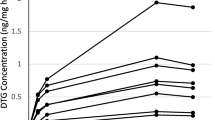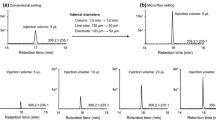Abstract
Sufficient drug exposure is crucial for maintaining durable responses to HIV treatments. However, monitoring drug exposure using single blood samples only provides short-term information and is highly subject to intra-individual pharmacokinetic variation. Drugs can accumulate in hair over a long period of time, so hair drug levels can provide drug exposure information over prolonged periods. We now report on a specific, sensitive, and reproducible liquid chromatography-tandem mass spectrometry method for measuring nevirapine (NVP), a widely used antiretroviral drug, levels in human hair using even a single short strand of hair. Hair samples are cut into small segments, and the drug is extracted in methanol/trifluoroacetic acid (v/v, 9:1) shaken at 37 °C in a water bath overnight, followed by liquid–liquid extraction under alkaline conditions. The extracted samples are then separated on a BDS-C18 column with a mobile phase composed of 50% acetonitrile containing 0.15% acetic acid and 4 mM ammonium acetate with an isocratic elution for a total run time of 3 min and detected by triple quadrupole electrospray multiple reaction mode at precursor/product ion at 267.0 > 225.9 m/z. Deuterated nevirapine-d5 was used as an internal standard. This method was validated from 0.25 to 100 ng/mg using 2 mg hair samples. The accuracies for spiked NVP hair control samples were 98–106% with coefficients of variation (CV) less than 10%. The CV for incurred hair control samples was less than 7%. The extraction efficiency for incurred control hair samples was estimated at more than 95% by repeated extractions. This method has been successfully applied to analyze more than 1,000 hair samples from participants in a large ongoing cohort study of HIV-infected participants. We also showed that NVP in human hair can easily be detected in a single short strand of hair. This method will allow us to identify drug non-adherence using even a single strand of hair.

Therapeutic drug monitoring using hair






Similar content being viewed by others
References
Osterberg L, Blaschke T (2005) Adherence to medication. New Engl J Med 353:487–497
Cramer J, Rosenheck R, Kirk G, Krol W, Krystal J (2003) Medication compliance feedback and monitoring in a clinical trial: predictors and outcomes. Value Health 6:566–573
Ickovics J, Meisler AW (1997) Adherence in AIDS clinical trials: a framework for clinical research and clinical care. J Clin Epidemiology 50:385–391
Vanhove GF, Schapiro JM, Winters MA, Merigan TC, Blaschke TF (1996) Patient compliance and drug failure in protease inhibitor monotherapy. JAMA 276:1955–1956
Paterson DL, Swindells S, Mohr J, Brester M, Vergis EN, Squier C, Wagener MM, Singh N (2000) Adherence to protease inhibitor therapy and outcomes in patients with HIV infection. Ann Intern Med 133:21–30
Condra JH, Schleif WA, Blahy OM, Gabryelski LJ, Graham DJ, Quintero JC, Rhodes A, Robbins HL, Roth E, Shivaprakash M, Titus D, Yang T, Tepplert H, Squires KE, Deutsch PJ, Emini EA (1995) In vivo emergence of HIV-1 variants resistant to multiple protease inhibitors. Nature 374:569–571
Salomon JA, Hogan DR, Stover J, Stanecki KA, Walker N, Ghys PD, Schwartländer B (2005) Integrating HIV prevention and treatment: from slogans to impact. PLoS Med 2:e16
Castilla J, Del Romero J, Hernando V, Marincovich B, García S, Rodríguez C (2005) Effectiveness of highly active antiretroviral therapy in reducing heterosexual transmission of HIV. J AIDS 40:96–101
Podsadecki TJ, Vrijens BC, Tousset EP, Rode RA, Hanna GJ (2008) “White coat compliance” limits the reliability of therapeutic drug monitoring in HIV-1-infected patients. HIV Clin Trials 9:238–246
Khoo SH, Lloyd J, Dalton M, Bonington A, Hart E, Gibbons S, Flegg P, Sweeney J, Wilkins EG, Back DJ (2006) Pharmacologic optimization of protease inhibitors and nonnucleoside reverse transcriptase inhibitors (POPIN)—a randomized controlled trial of therapeutic drug monitoring and adherence support. J AIDS 41:461–467
Burger DM, Hugen PW, Aarnoutse RE, Hoetelmans RM, Jambroes M, Nieuwkerk PT, Schreij G, Schneider MM, van der Ende ME, Lange JM (2003) Treatment failure of nelfinavir-containing triple therapy can largely be explained by low nelfinavir plasma concentrations. Ther Drug Monit 25:73–80
Clevenbergh P, Garraffo R, Durant J, Dellamonica P (2002) PharmAdapt: a randomized prospective study to evaluate the benefit of therapeutic monitoring of protease inhibitors: 12 week results. AIDS 16:2311–2315
Back D, Gatti G, Fletcher C, Garaffo R, Haubrich R, Hoetelmans R, Kurowski M, Luber A, Merry C, Perno CF (2002) Therapeutic drug monitoring in HIV infection: current status and future directions. AIDS 16(Suppl 1):S5–S37
Back D, Gibbons S, Khoo S (2006) An update on therapeutic drug monitoring for antiretroviral drugs. Ther Drug Monit 28:468–473
Nettles RE, Kieffer TL, Parsons T, Johnson J, Cofrancesco J Jr, Gallant JE, Carson KA, Siliciano RF, Flexner C (2006) Marked intraindividual variability in antiretroviral concentrations may limit the utility of therapeutic drug monitoring. Clin Infec Dis 42:1189–1196
Nakahara Y (1999) Hair analysis for abused and therapeutic drugs. J Chromatogr B Biomed Sci Appl 733:161–180
Uematsu T (1993) Therapeutic drug monitoring in hair samples. Principles and practice. Clin Pharmacokin 25:83–87
Gandhi M, Greenblatt RM (2002) Hair it is: the long and short of monitoring antiretroviral treatment. Ann Intern Med 137:696–697
Beumer JH, Bosman IJ, Maes RA (2001) Hair as a biological specimen for therapeutic drug monitoring. Int J Clin Pract 55:353–357
Bernard L, Vuagnat A, Peytavin G, Hallouin MC, Bouhour D, Nguyen TH, Vildé JL, Bricaire F, Raguin G, de Truchis P, Ghez D, Duong M, Perronne C (2002) Relationship between levels of indinavir in hair and virologic response to highly active antiretroviral therapy. Ann Intern Med 137:656–659
Servais J, Peytavin G, Arendt V, Staub T, Schneider F, Hemmer R, Burtonboy G, Schmit JC (2001) Indinavir hair concentration in highly active antiretroviral therapy-treated patients: association with viral load and drug resistance. AIDS 15:941–943
Duval X, Peytavin G, Breton G, Ecobichon JL, Descamps D, Thabut G, Leport C (2007) Hair versus plasma concentrations as indicator of indinavir exposure in HIV-1-infected patients treated with indinavir/ritonavir combination. AIDS 21:106–108
Huang Y, Gandhi M, Greenblatt RM, Gee W, Lin ET, Messenkoff N (2008) Sensitive analysis of anti-HIV drugs, efavirenz, lopinavir and ritonavir, in human hair by liquid chromatography coupled with tandem mass spectrometry. Rapid Commun Mass Spectrom 22:3401–3409
Gandhi M, Ameli N, Bacchetti P, Gange SJ, Anastos K, Levine A, Hyman CL, Cohen M, Young M, Huang Y, Greenblatt RM (2009) Protease inhibitor levels in hair strongly predict virologic response to treatment. AIDS 23:471–478
Gandhi M, Ameli N, Bacchetti P, Anastos K, Gange SJ, Minkoff H, Young M, Milam J, Cohen MH, Sharp GB, Huang Y, Greenblatt RM (2011) Atazanavir concentration in hair is the strongest predictor of outcomes on antiretroviral therapy. Clin Infect Dis 52:1267–1275
Gandhi M, Ameli N, Bacchetti P, Huang Y, Gange SJ, Anastos K, Levine A, Cohen M, Young M, Greenblatt RM (2009) Concentrations of Efavirenz in Hair Are Strongly Correlated with Virologic Response. 16th Conference on Retroviruses and Opportunistic Infections (CROI), Montreal, Canada, February 8–11
van Zyl GU, van Mens TE, Mcilleron H, Zeier M, Nachega JB, Decloedt E, Malavazzi C, Smith P, Huang Y, van der Merwe L, Gandhi M, Maartens G (2011) Low lopinavir plasma or hair concentrations explain second-line protease inhibitor failures in a resource-limited setting. J AIDS 56:333–339
Murphy R, Montaner J (1996) Nevirapine: a review of its development, pharmacological profile and potential for clinical use. J Expert Opinion on Investigational Drugs 5:1183–1199
Sullivan JL (2003) Prevention of mother-to-child transmission of HIV–what next? J AIDS 34(Suppl 1):S67–S72
Duong M, Buisson M, Peytavin G, Kohli E, Piroth L, Martha B, Grappin M, Chavanet P, Portier H (2005) Low trough plasma concentrations of nevirapine associated with virologic rebounds in HIV-infected patients who switched from protease inhibitors. Ann Pharmacother 39:603–609
Gonzalez de Requena D, Nunez M, Jimenez-Nacher I, Soriano V (2002) Liver toxicity caused by nevirapine. AIDS 16:290–291
McKoy JM, Bennett CL, Scheetz MH, Differding V, Chandler KL, Scarsi KK, Yarnold PR, Sutton S, Palella F, Johnson S, Obadina E, Raisch DW, Parada JP (2009) Hepatotoxicity associated with long- versus short-course HIV-prophylactic nevirapine use: a systematic review and meta-analysis from the Research on Adverse Drug events And Reports (RADAR) project. Drug Saf 32:147–158
Martínez E, Blanco JL, Arnaiz JA, Pérez-Cuevas JB, Mocroft A, Cruceta A, Marcos MA, Milinkovic A, García-Viejo MA, Mallolas J, Carné X, Phillips A, Gatell JM (2001) Hepatotoxicity in HIV-1-infected patients receiving nevirapine-containing antiretroviral therapy. AIDS 15:1261–1268
Barkan SE, Melnick SL, Preston-Martin S, Weber K, Kalish LA, Miotti P, Young M, Greenblatt R, Sacks H, Feldman J (1998) The Women’s Interagency HIV Study. WIHS Collaborative Study Group. Epidemiology 9:117–125
Viswanathan CT, Bansal S, Booth B, DeStefano AJ, Rose MJ, Sailstad J, Shah VP, Skelly JP, Swann PG, Weiner R (2007) Workshop/Conference Report-Quantitative bioanalytical methods validation and implementation: best practices for chromatographic and ligand binding assays. AAPS J 9:E30–E42
Spooner N (2010) A glowing future for dried blood spot sampling. Bioanalysis 2:1343–1344
Amsterdam P, Waldrop C (2010) The application of dried blood spot sampling in global clinical trials. Bioanalysis 2:1783–1786
Acknowledgment
We thank Richard Bonderud for his critical review of this manuscript. We thank the WIHS participants who contributed hair specimens for this study. This study is supported by NIH/NIAID Grant R01 AI 065233- and also U01AI034989.
Author information
Authors and Affiliations
Corresponding author
Electronic supplementary material
Below is the link to the electronic supplementary material.
ESM 1
(PDF 194 kb)
Rights and permissions
About this article
Cite this article
Huang, Y., Yang, Q., Yoon, K. et al. Microanalysis of the antiretroviral nevirapine in human hair from HIV-infected patients by liquid chromatography-tandem mass spectrometry. Anal Bioanal Chem 401, 1923–1933 (2011). https://doi.org/10.1007/s00216-011-5278-7
Received:
Revised:
Accepted:
Published:
Issue Date:
DOI: https://doi.org/10.1007/s00216-011-5278-7




